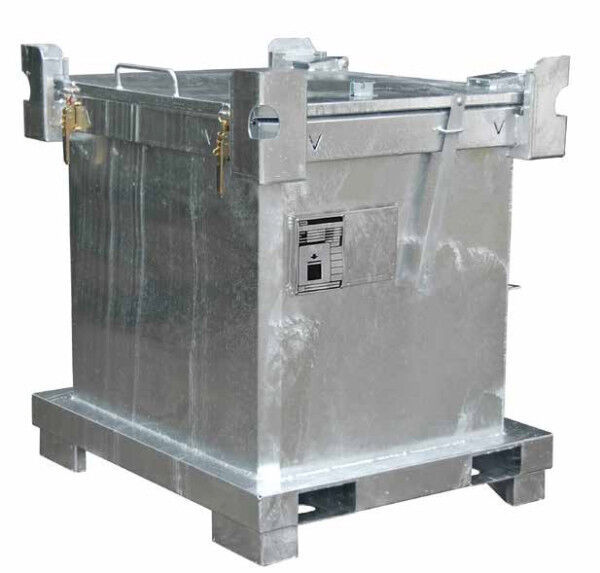incl. VAT.
Please note: Notes on delivery time
Free shipping (Germany, mainland)!
Shippingtime: ca. 3-4 Wo.
- Article no: TPBVG1SA800

Questions about the article?
Our staff member Petra Fürbeck is happy to help you:
+49 (0) 7151 - 256 4817 or info@lion-care.com
| max. gross mass: | 1415 kg |
| Handling the filling material: | Filling material in cushions |
| Empty weight: | 175 kg |
| Material name: | Sheet steel (hot-dip galvanized) |
| Volume: | 800 l |
| Packaging group: | Packaging group I, Packaging group II |
| Packaging instructions according to ADR: | PI 903, PI 908, PI 909, PI 910 |
| ADR special provision: | SP 310, SP 376, SP 377 |
| UN packaging code: | 4A/X/S/D/BAM 6917-BAUER, 11A/X/D/BAM 6007-BAUER/4960 |
| Areas of application: | Prototypes, Transportation of EOL lithium-ion batteries, Outdoor storage, Waste disposal, fire-protected storage, stationary containment, Transport of rechargeable batteries, Storage, Transportation |
| External dimensions: | 1200 x 1000 x 1235 mm |
| Filling material: | Vermiculite, without filling material, PyroBubbles® |
| Internal dimensions: | 1038 x 838 x 927 mm |
The SAP 800-1 transport and storage container is ideal as a collection container for lithium-ion batteries for almost all conditions.
Size and capacity of the transport and storage container
The container has external dimensions of approx. 1200 x 1000 x 1235 mm (LxWxH). Inside the box, the dimensions are 1038 x 838 x 927 mm (LxWxH), which corresponds to a capacity of approx. 800 l. The tare weight of the transport container is approx. 175 kg. The maximum permissible total weight is 1415 kg. The container is double-coded as 11A and 4A packaging. The stable base frame can be retracted on 2 sides for industrial trucks. The container can be stacked 3 high. The box is a sturdy construction made of 2 mm sheet steel. The lid has a thickness of 2.5 mm.
Application and structure of the SAP 800-1 transport and storage container
Before each use, the integrity of the container and all components must be checked. Only trained and instructed personnel may be assigned to set up, store, move and transport the container. The transport and storage container must be filled with filler and batteries layer by layer until the maximum gross mass is reached. We offer two variants of filling material: Either vermiculite filler pillows or PyroBubbles filler pillows. If you wish to use your own filler, which you already have in stock at your company, the container can also be ordered without filler. The container can also be moved using 4 lifting eyes on the top frame. The lid support can be locked at an angle of 70°. The complete lid lock is 270°. One of the 4 lid supports is lockable.
Storage instructions
The storage of hazardous goods in defective and leaking transport containers is prohibited. The storage area must be set up on a level surface, well ventilated and under a roof. Care must be taken to ensure that the transport container is protected from the weather, direct sunlight and radiant heat.
Transport instructions
All legal regulations as well as any markings and labels must be observed during transportation. All handling and transportation of the container must be carried out using suitable and safe means. Before transportation, make sure that the hood is firmly attached to the base frame. Observe the instructions for labeling and marking specified in the ADR.
Repair and disposal
Damaged transport containers must not be reused. Repairs may only be carried out by specialists authorized by the manufacturer or by the manufacturer himself. Contaminated components must be disposed of properly in accordance with their contamination.
Certification and guidelines
Lithium batteries fall into dangerous goods class 9, which means that numerous specifications and guidelines must be observed when transporting lithium batteries.
Certified for packaging groups I, II and III
The SAP 600 container meets the requirements of packaging groups I, II and III, which means that substances with high, medium and low hazard potential may be transported in it. To achieve this classification, drop tests from 1.8 m must be passed. All packaging with the code "X" may be used for packaging groups I (II and III). The X-coding is also available in the context of double coding.
Suitable for transportation within the meaning of SV 376 of the ADR and packing instruction P 908
All lithium-ion cells or batteries and lithium-metal cells or batteries that have been damaged and no longer comply with the applicable regulations according to their manual must comply with the provisions of Special Provision 376 (SV 376). This applies, for example, to cells that have leaked or degassed, have suffered external or mechanical damage or have been identified as defective for safety reasons or could no longer be diagnosed prior to transportation. These cells must then be packed in accordance with packing instruction P 908. According to this directive, for example, it must be ensured that any electrolytes released are absorbed and a non-electrically conductive thermal insulation material must ensure that the environment is protected from dangerous heat generation.
For storage, transportation and recycling in accordance with SV 377 of the ADR and packaging instruction P 909
Special provision SV 377 regulates the transportation of lithium-ion cells or batteries and lithium-metal cells or batteries that are transported for disposal or recycling. Similar to packing instruction P 908, guidelines for packing group II must be observed in P 909. In addition, restrictions on the nominal energy and weight of the lithium-ion cells and batteries apply.
Prototype transports according to SV 310 of the ADR and packing instruction P 910
The special provision SV 310 regulates the transportation of prototypes of lithium-ion cells or batteries and lithium-metal cells or batteries. Packaging instruction P 910 then specifies requirements for packaging and the mass of dangerous goods, among other things.
Also ideal for the transportation of new lithium-ion batteries in accordance with P 903 and as a storage and quarantine box
As no filler is required, the container is also ideal as a quarantine container for defective batteries in order to isolate a possible fire from the outset. The transport container is also suitable for the regular shipping of new goods or undamaged lithium-ion batteries in accordance with packaging regulation P 903.
Please note: The "SAP" type containers must not be used for "critically" defective lithium-ion batteries as defined by SV 376 and P911.
Future-oriented
Lithium-ion batteries will be indispensable in all industrial applications in the coming years. However, if used incorrectly, batteries can pose a potential hazard during production, storage and transportation that should not be underestimated. By purchasing these boxes, you protect yourself against major financial losses right from the start.
The manufacturer
Bauer GmbH is a globally active company that specializes in the development, production and sale of forklift attachments, environmental protection equipment and recycling and waste containers. With more than 280 employees, Bauer is one of the leading manufacturers in Europe. The company pursues a corporate philosophy that is tailored to individual customer needs and is characterized by innovation and environmental friendliness.
Bauer guarantees the highest safety and quality standards through the use of qualified employees and state-of-the-art production technologies. The company has been certified to DIN EN ISO 9001:2008 since 1993, which ensures the consistently high quality of products "made by Bauer". Production takes place exclusively at the Südlohn and Halberstadt plants.
In action for you
Please do not hesitate to contact us if you have any questions. We look forward to hearing from you!
| Suitable for critically defective?: | No |
| max. gross mass: | 1415 kg |
| Coding: | 11A, 4A |
| Filling material supplied: | without filling material, PyroBubbles® (Füllkissen), Vermiculite (filling cushion) |
| Volume: | 84 - 600 l |
| Type of packaging: | Dangerous goods packaging < 450 liters or < 400 kg net |
| Handling the filling material: | Filling material in cushions |
| Material: | Steel |
| Type: | Storage box |
| Empty weight: | 175 kg |
| Material name: | Sheet steel (hot-dip galvanized) |
| Volume: | 800 l |
| Packaging group: | Packaging group I, Packaging group II |
| Packaging instructions according to ADR: | PI 903, PI 908, PI 909, PI 910 |
| ADR special provision: | SP 310, SP 376, SP 377 |
| UN packaging code: | 4A/X/S/D/BAM 6917-BAUER, 11A/X/D/BAM 6007-BAUER/4960 |
| Areas of application: | Prototypes, Transportation of EOL lithium-ion batteries, Outdoor storage, Waste disposal, fire-protected storage, stationary containment, Transport of rechargeable batteries, Storage, Transportation |
| External dimensions: | 1200 x 1000 x 1235 mm |
| Filling material: | Vermiculite, without filling material, PyroBubbles® |
| Internal dimensions: | 1038 x 838 x 927 mm |
That depends on various factors that need to be considered:
- size of the battery(ies)
- condition (e.g. non-critical, defective, critically defective or prototype)
- power
Transport boxes are available in many different sizes and specifications. The packaging group for which the box is suitable is indicated for each product.
Find out more in our blog article:
https://www.lion-care.com/aktuelles/blog/transportvorschriften-regeln-und-sicherheitsmassnahmen
Even if the batteries are not critical, remember to protect them from shocks and to order appropriate filling material if it is not already included in the box.
Yes. Should a battery reach a critical state and cause a fire, separating the batteries will prevent the fire from spreading and multiplying.
Generally, the insulation and protection material should line all sides of the container. The batteries are stored between individual layers.
We also have containers in our program that already have the protective material integrated into the outer wall. No further protective layer is necessary here.
The technical principles for storage and transportation solutions are very similar. The transport boxes are also subjected to extensive tests in accordance with ADR (drop test, fire test, etc.) to confirm compliance with the ADR regulations. The packaging regulations are extensive and regulated by law.
There are currently no comparable regulations for storage. Nevertheless, manufacturers of storage boxes regularly carry out appropriate tests.
The right container depends on the type and size of the battery to be shipped or stored.
If you want to learn more about battery storage and transportation, you will find the answers in our blog articles:
https://www.lion-care.com/aktuelles/blog/transportvorschriften-regeln-und-sicherheitsmassnahmen
https://www.lion-care.com/aktuelles/blog/lithium-ionen-akkus-sicherer-umgang-und-richtige-lagerung
The transportation of batteries is subject to ADR regulations.
The number, size and weight, energy density and condition of the batteries are crucial parameters for finding a suitable transport container for lithium-ion batteries. The selection process is complex and should be carried out by appropriately trained personnel. We have a trained hazardous materials officer on our team. Please feel free to contact us.
Plastic containers are cheaper but not as durable as metal containers. They are suitable, for example, for non-critical batteries, defective batteries, prototypes and end-of-life batteries. They can be used for both storage and transportation.
Metal containers are required, for example, when dealing with critically defective batteries.
The exact packaging instructions for these cases can be found in the ADR or by consulting a certified hazardous materials specialist.
To date, there are no legal requirements for the storage of lithium-ion batteries, which does not mean that they should be stored without suitable protective measures.
It is best to check with your insurer to find out which measures they recognize as suitable in the event of a claim.
For example, a suitable box could already be recognized as spatial separation.
A rough overview can be found in this VDS publication from the GDV:
https://shop. vds.de/download/vds-3103/ccb1d439-ad9d-47cb-a2b1-ace23e155610
Please also read our blog article on this topic:
https://www.lion-care.com/aktuelles/blog/lithium-ionen-akkus-sicherer-umgang-und-richtige-lagerung







